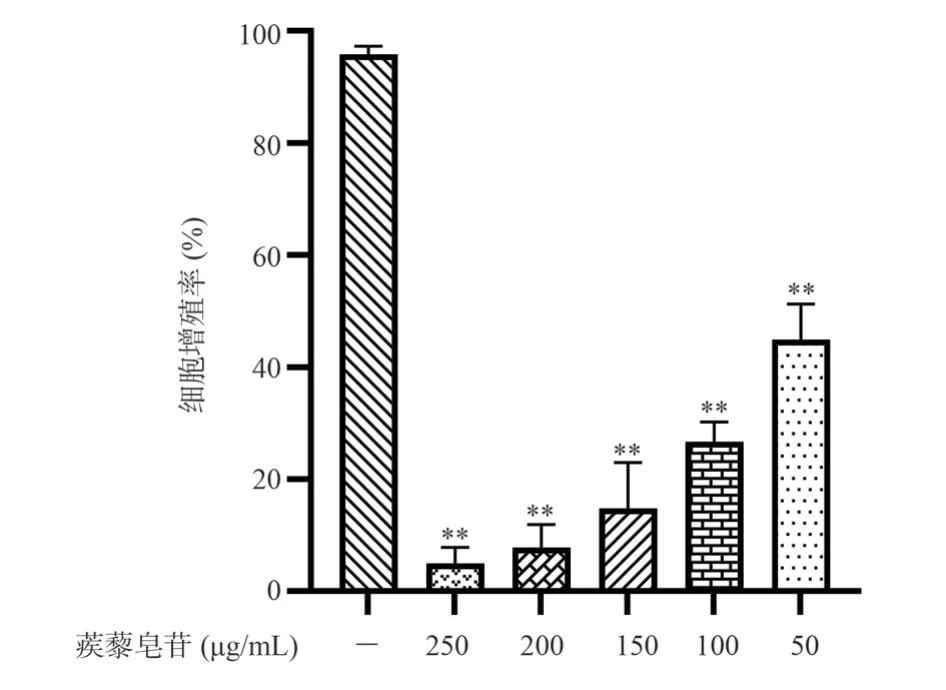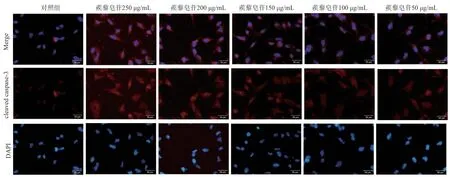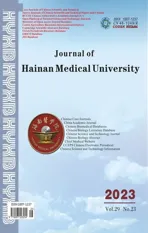Effects of Tribulus terrestris saponins on proliferation and invasion of A549 cells
2023-03-06TANGHuanhuanHUANGYananLUZaiqing4ZHOUXiangdongZHANGHaibinLIQiLIUHelu
TANG Huan-huan, HUANG Ya-nan, LU Zai-qing4, ZHOU Xiang-dong,2✉, ZHANG Haibin, LI Qi,2, LIU He-lu
1. Department of Respiratory Medicine, The First Affiliated Hospital of Hainan Medical College, Haikou 570102, China
2. Hainan Respiratory Disease Clinical Medical Center, Haikou 571199, China
3. Institute of Deep-sea Science and Engineering, Chinese Academy of Sciences, Sanya 572000, China
4. Key Laboratory of Mariculture, Ministry of Education, Ocean University of China, Qingdao 266000, China
Keywords:
ABSTRACT Objective: Tribulus terrestris saponin is a traditional Chinese medicine in China.This experiment was designed to investigate the effects of tribulus terrestris saponin on the proliferation and invasion ability of non-small cell lung cancer A549 cells.Methods: A549 cells were divided into normal control and experimental groups (Tribulus terrestris saponin 250 μg/mL group, Tribulus terrestris saponin 200 μg/mL group, Tribulus terrestris saponin 150 μg/mL group, Tribulus terrestris saponin 100 μg/mL group, Tribulus terrestris saponin 50 μg/mL group).The proliferation viability of the cells in each group was detected by CCK8, the invasion of tumor cells was detected by Transwell model.The mRNA expression of MMP9 and caspase-3 in each group of cells was detected by RT-PCR.Immunofluorescence staining was used to observe the fluorescence intensity of caspase-3 in each group of cells.Results:Compared with the normal control group, tribulus terrestris saponin significantly inhibited the proliferation activity and invasion ability of A549 cells, which was statistically significant(P<0.01).In the invasion assay, compared with the control group, MMP9 expression was significantly reduced and caspase-3 expression was significantly increased in the tribulus terrestris saponin group, and both were concentration-dependent, with statistically significant differences (P<0.01).By cellular immunofluorescence staining experiments, it was found that the fluorescence expression of caspase-3 was enhanced in the experimental group compared with the normal control group, in which the high concentration saponin group was significantly higher than the low concentration group.Conclusion: Tribulus terrestris saponin can inhibit the invasive ability of A549 cells by down-regulating the expression of MMP9, and induce irreversible apoptosis by up-regulating the activation of caspase-3 expression to form caspase-3.
1.Introduction
Lung cancer is a common malignant tumor that can be divided into small cell lung cancer and non-small cell lung cancer according to its pathological type.Among them, NSCLC accounts for the highest proportion, with a maximum of 85%.NSCLC has a high degree of malignancy, and relevant studies have shown that the 5-year survival rate of NSCLC patients is less than 20%[1].At present,the main treatment methods for cancer include surgical resection of the cancer lesion, supplemented by targeted radiotherapy and chemotherapy treatment.At present, the main treatment methods for cancer include surgical resection of the cancer lesion, supplemented by targeted radiotherapy and chemotherapy.But when cancer metastasizes and spreads, surgical resection is of little significance,while radiotherapy and chemotherapy have various adverse reactions,such as nausea, severe vomiting, headache, etc.This makes it difficult for some patients to persist, leading to irregular treatment and even interruption of treatment.China has abundant resources of Chinese herbal medicine, which has played a certain role in antiinflammatory[2] and cancer suppression[3].Some plant components have been extensively studied for the development of new cancer suppressants due to their cancer suppressive effects and minimal side effects, such as Paris forrestii[4], Amomum villosum[5] and Tribulus terrestris[6].Tribulus terrestris has a bitter and pungent taste, and a warm nature.It often grows in roadside grass, fields, and sandy areas.It has been used as a folk medicine in China for thousands of years[7].Research has found that saponins extracted from Tribulus terrestris have pharmacological effects such as improving myocardial function[8], improving memory impairment[9], antidepressant[10-11], optic nerve protection[12], and anti-tumor effects[13].The role of tribulus saponins in lung cancer is not yet clear.This article takes A549 cells as the research object to explore the effect of tribulus saponins on the proliferation and invasion of A549 cells.
2.Materials and Methods
2.1 Materials
2.1.1 Cell line
A549 cells are provided by the Marine Biology Ecology and Evolution Research Group of the Institute of Deep Sea Science and Engineering, Chinese Academy of Sciences.
2.1.2 Experimental drugs and reagents
RPMI 1640 culture medium(Gibco Company); fetal bovine serum(CLARK Company ,America);CCK8reagent kit (Biosharp Company); trypsin(Solebao Company);PBS buffer(Shanghai Shenggong Company); Tribulus terrestris(Shaanxi Huashi Biotechnology company); Matrigel adhesive(Corning Company);Caspase-3 rabbit monoclonal antibody,Anti-rabbit IgG(H+L), F(ab’)2 Fragment sheep anti rabbit polyclonal antibody(CST Company);Reverse transcription kit(TAKARACompany).
2.1.3 Experimental instruments
Constant temperature water bath (Suzhou Antai Air Technology Co., Ltd.); Small centrifuge (Hangzhou Aosheng Instrument Co.,Ltd.); Enzyme labeling instrument, PCR instrument, cell constant temperature incubator (Thermofly Company); High speed centrifuge(Eppendorp company); Confocal laser microscope, inverted microscope (Olympus company).
2.2 Methods
2.2.1 Cell culture and passage
Routine culture of A549 cells using RPMI 1640+10% fetal bovine serum and incubate in a 5% CO2and 37 ℃ cell incubator for 48 h before changing the solution.When the cells fuse to 70% to 80%,digestion is terminated and inoculated into a culture dish in a ratio of 1:2 for passage culture, or inoculated into a 6-well or 96-well plate for subsequent experiments.
2.2.2 Cell grouping and administration
Divide cells into normal control group and experimental group(Tribulus terrestris saponin 250 μg/mL,200 μG/mL group,150 μg/mL group, 100 μg/mL group and tribulus saponin 50 μg/mL group).Each group of cells was cultured with RPMI 1640+10%fetal bovine serum and adhered to the wall.Pour out the original culture medium, the normal control group was cultured in RPMI 1640 medium for 24 h, while the experimental group was cultured in RPMI 1640 medium with equal amounts of different concentrations of tribulus saponins for 24 h.
2.2.3 CCK-8 for detecting cell proliferation ability
Arrange cells according to 1×104pieces/hole (100 μL) inoculate on a 96 well plate.After the cells adhere to the wall, discard the culture medium, group and administer the same as 1.2.2.After being placed in a cell incubator for further cultivation for 24 h, add 10 μL to each well incubate CCK-8 solution in an incubator for another 1 hour,and measure the absorbance values of each well at 450 nm using an enzyme-linked immunosorbent assay.Each group is equipped with 5 multiple wells.Using culture medium without cells as the blank group, calculate cell viability according to the following formula:Cell proliferation rate=(Experimental group OD value-Blank group OD value)/(Control group OD value-Blank group OD value)×100%.
2.2.4 Transwell invasion experiment
Dilute Matrigel gel in serum-free cell culture medium at a ratio of 1:8.Take 100 μL Apply on the surface of the PET film evenly in the Transwell chamber.Place the small chamber in a 24 well plate hole and let it sit at 37 ℃ for about 3 hours.Then, take it out and dry it overnight in a super clean table at room temperature.Inoculate logarithmic growth stage cells into a 6-well plate,group and administer as in 1.2.2.After 24 h of treatment with cell administration, the cells were digested by trypsin and centrifuged at 1 000 rpm for 3 min to collect cell precipitates.Cell precipitates were resuspended using serum-free culture medium, and the cell count was adjusted to 2×104/mL.Place the Transwell cells treated with Matrigel into a 24 well culture plate.Add 200 μL cell suspensions to each group separately in the small room (cell count 4×103), add 600 μL culture medium containing 10% fetal bovine serum to the lower chamber.Incubate in a constant temperature incubator for 24 h, fix cells with 4% paraformaldehyde for 15 min, stain with 2.5% crystal violet staining solution for 15 min, and observe cell invasion under an inverted microscope.
2.2.5 RT-PCR for detecting mRNA levels of MMP9 and Caspase3
Cell grouping and administration are the same as 1.2.2.Extract total RNA from each group using Trizol reagent, and measure the concentration and absorbance values of RNA at 260 nm and 280 nm using a nucleic acid detector.The A260/A280 ratio of the sample was between 1.8 and 2.0, and the RNA integrity was detected by 1% agarose gel.Using a two-step method for RT-PCR, the primer sequence is shown in Table 1.The PCR products were identified by 1.5% agarose gel electrophoresis.The results were analyzed by optical density area integral analysis, and the ratio of the PCR products to the housekeeping gene GAPDH mRNA was taken as the relative value of the target gene mRNA.
2.2.6 Cellular immunofluorescence
Cell grouping and administration are the same as 1.2.2.After 24hours of medication treatment in each group, discard the culture medium and wash it with PBS three times.Cells were fixed with 4%paraformaldehyde for 15 min and incubated at room temperature with 5% BSA blocking solution for 2 h.Discard the blocking solution and add Caspase-3 rabbit monoclonal antibody (1:1 000) for overnight incubation at 4℃.Wash 3 times with PBS solution and add fluorescent labeled goat anti rabbit secondary antibody (1:1 000).Incubate at 37 ℃ in dark for 1 hour, clean with PBS, and add DAPI staining to each group for 5 min.Use anti fluorescence suppressant to seal the film and collect and analyze images under a confocal laser microscope.

Tab 1 Primer Sequences of RT-PCR Target Genes
2.3 Statistics
Statistical analysis was conducted using SPSS 25 software, with econometric data expressed in (±s), inter group comparisons using t-tests, and multi group comparisons using one-way ANOVA.
3.Result
3.1 Tribulus terrestris saponins inhibit the proliferation activity of A549 cells effectively
Compared with the control group, the proliferation of A549 cells in the experimental group was significantly inhibited after 24 h of treatment with saponins from Tribulus terrestris.With the increase of concentration in tribulus terrestris saponin, its cell proliferation ability is significantly lower than the control group, and the difference is statistically significant (P<0.05)(Figure 1 and Table 2).
3.2 Tribulus terrestris saponins inhibit the invasive ability of A549 cells effectively

Fig 1 Effects of different concentrations of tribulus terrestris saponins on A549 proliferation

Tab 2 Effects of different concentrations of tribulus terrestris saponins on A549 proliferation
Evaluate the invasive ability of tumor cells using the Transwell cell model.After 24 h of drug intervention with different concentrations of drugs, compared with the blank control group, the experimental group showed that as the drug concentration increased, the number of cells passing through the chamber decreased.It’s indicating that the high concentration group had a higher impact on the invasiveness of cells, and the difference was statistically significant(P<0.01).The experiment suggests that Tribulus terrestris saponins reduce the invasive ability of A549 cells effectively (Figure 2 and Table 3).
3.3 mRNA Transcription of MMP9 and Caspase-3 in Cells
MMP9 is an important marker in the migration and invasion process of tumor cells, and its activity level has a certain indicator role in determining the migration and invasion ability of drugs to tumor cells.When cells are stimulated by apoptosis related signals,caspase-3 is activated, forming an apoptotic cascade reaction that induces cell apoptosis.Compared with the control group, the transcription level of MMP9 in the experimental group cells was significantly reduced, while caspase-3 was significantly increased,with statistical significance(P<0.01).This indicates that the effect of Tribulus terrestris saponins on the invasion ability of A549 may be related to the regulation of MMP9, and the effect of Tribulus terrestris saponin on A549 apoptosis may be related to the activation of caspase-3(Table 4).

Tab 3 Effects of Tribulus terrestris saponins on the invasive ability of A549 cells

Tab 4 mRNA expression levels of MMP9 and caspase-3 in each group
3.4 Immunofluorescence expression of Caspase-3 in each group of cells
The experimental results showed that the fluorescence expression of caspase-3 was lower in the control group, while the fluorescence expression of caspase-3 was significantly higher in the experimental group than in the control group, and was more pronounced in the high concentration group.The experiment suggests that tribulus terrestris saponins may increase the expression of caspase-3, thereby increasing apoptosis in A549 cells(Fig 3).

Fig 3 Caspase-3 fluorescence of cells in each group (200 ×)
4.Discussion
Tribulus terrestris was first recorded in the “Shennong Materia Medica Classic” ,which has been widely used in traditional Chinese medicine in China since ancient times.The ingredients of traditional Chinese medicine tribulus include saponins, flavonoids, alkaloids,polysaccharide and other compounds, among which saponin is one of the main active ingredients.In previous studies, it has been found that tribulus terrestris saponins have various effects, such as protecting myocardial cells, improving myocardial function[14],and reducing inflammatory damage[15].In addition, the tribulus terrestris saponins also has a significant effect of inhibiting tumor proliferation.Zhang[6] et al.found that tribulus terrestris saponin can significantly decrease the proliferative activity of gastric cancer cells,and this activity may be related to the decrease in the expression of Nin one binding 1(NOB 1).NOB 1 expression is higher in tumor tissue than in normal cells, and its abnormal expression can promote the growth of tumor cells[16].This suggests that tribulus terrestris saponin may act against the malignant growth of gastric cancer cells by inhibiting the expression of NOB 1.In the study of bladder cancer cell J82, Yu[17] et al found that tribulus terrestris saponins can increase the levels of Bax and caspase-3 proteins by regulating long chain non coding RNA (LncRNA) - NKILA to promote apoptosis of gastric cancer cells.In summary, the effect of tribulus terrestris saponins on tumor cells may be related to the regulation of various apoptotic factors.
The malignancy of tumor cells is reflected in their strong invasiveness and infinite proliferation ability.Tumor cells achieve metastasis by invading and damaging surrounding tissues, infiltrating normal cells.Matrix metalloproteinases (MMPs) are a class of calcium ion dependent zinc containing endopeptidases containing 25 highly homologous family members, with multiple family members.MMP9 is the enzyme with the largest molecular weight in the family[18].MMP9 is secreted in the form of zymogen, which can form type IV collagenase upon activation.Its function is to degrade and destroy type IV collagen in the extracellular matrix[19-20].Type IV collagen is the basic skeleton that constitutes the extracellular matrix.Tumor cells activate MMP9 to destroy the extracellular matrix skeleton, resulting in matrix loss.Tumor cells can use this to infiltrate surrounding tissues, ultimately completing tumor invasion and metastasis, and even breaking through the vascular intima.In the research by Abdullah[21] et al., it was found that the tribulus terrestris saponins can reduce the invasive ability of liver cancer cells, which is related to the regulation of the decrease of MMP9 and MMP2.In this experiment, we found that as the concentration of tribulus terrestris saponins increased, the invasiveness of A549 cells gradually decreased.The transcription level of MMP9 decreased with the increase of tribulus terrestris saponins concentration, indicating that the impact of tribulus terrestris saponins on the invasiveness of A549 cells may be related to MMP9.
Cysteinyl aspartate specific proteinase(Caspase) is a protein family related to cell apoptosis.Under normal circumstances, caspase exists in the form of inactive zymogen and is activated when stimulated by apoptotic related signals, forming an apoptotic cascade reaction that induces cell apoptosis[22].Caspase-3 is a downstream factor of caspase apoptosis cascade reaction, and its activation can induce irreversible apoptosis in cells[6,23].In a study on triple negative breast cancer[24], anticancer agents made of tribulus terrestris saponins can promote apoptosis of breast cancer cells by activating caspase-3.In this experiment, the mRNA expression of caspase-3 in the experimental group was significantly higher than that in the control group.As the concentration of tribulus saponins increased, its mRNA expression increased.In the cell immunofluorescence experiment,with the increase of the concentration of tribulus terrestris saponins,the fluorescence expression of caspase-3 also significantly increased.In summary, the effect of tribulus terrestris saponins on A549 apoptosis may be related to the activation of caspase-3 expression.
As a common traditional Chinese medicine ingredient in China,tribulus terrestris saponins have various biological activities.This study found that the effect of tribulus terrestris saponins on the proliferation and invasion ability of A549 cells may be related to the regulation of caspase-3 and MMP-9.The next step of our research group is to establish an in vitro animal tumor model to explore the effect of tribulus terrestris saponins on the size of solid tumors and the side effects of treatment with tribulus terrestris saponins in diseased animals.This will provide assistance for the development of new anti lung cancer drugs.
Authors’ contribution The experimental design was designed by Zhou Xiangdong, and the experimental guidance was provided by Zhang Haibin, Li Qi,and Liu Helu.The experimental implementation was carried out by Tang Huanhuan, Huang Yanan, and Lu Zaiqing.Tang Huanhuan completed the article writing.Reviewed by Zhou Xiangdong.
The article does not involve any related conflicts of interest.
杂志排行
Journal of Hainan Medical College的其它文章
- Compound fufangteng mixture affects the expression of CD69 on CD11b + monocytes in immunosuppressed mice
- The mechanism of regulating macrophage polarization based on Notch1 signaling pathway to improve joint inflammation in adjuvant arthritis rats
- Mechanism of Sanshi decoction in the treatment of gouty arthritis by NLRP3 inflammasome
- Predictive value of controlling nutritional status score for progression to chronic critical illness in elderly patients with sepsis
- SPHK1 expression in gastric cancer and clinical value based on bioinformatics analysis
- Meta-analysis of the effects of high-intensity intermittent exercise on cardiopulmonary function rehabilitation in patients with stroke
